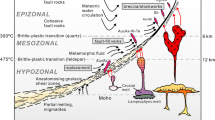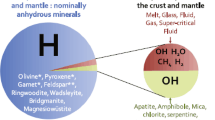Abstract
Ferromanganese (Fe-Mn) crusts in the ocean accumulate significant amounts of strategically important elements necessary for the development of high technologies. The recent study of Fe-Mn crusts shows that they noticeably vary in different oceans, and the purpose of this work is to compare the composition of Fe-Mn crusts from the Arctic and Atlantic oceans to reveal their similar features and differences and to associate them with a specific sedimentation environment. The chemical and mineral composition of Fe-Mn crusts from Knipovich Ridge located in the Arctic Ocean and from Brazil Basin in the Atlantic Ocean have been studied. Published data were used to increase the reliability of the conclusions. The Arctic Ocean crusts show specific characteristics such as low content of manganese, cobalt, and cerium and a high content of detrital material (Al), lithium, arsenic, thallium, and thorium. Previous data on high vanadium content are not confirmed. Low manganese content and the Mn/Fe ratio in the Arctic Ocean crusts negatively correlate with the accumulation of ice-rafted detrital material (Al is used as an indicator). This relationship indicates that the main difference of the Arctic Ocean crusts in comparison to the Atlantic Ocean crusts is associated with the fact that rocks supplied with ice are not equilibrated with seawater and contain Fe2+. The latter reduces manganese from MnO2 during the halmyrolysis, lowering the Mn/Fe ratio in the crusts.













Similar content being viewed by others
REFERENCES
E. S. Bazilevskaya and S. G. Skolotnev, “Iron-manganese formations on seamounts of the Brazil Basin (South Atlantic),” Dokl. Earth Sci. 439, 1039–1043 (2011).
E. S. Bazilevskaya and S. G. Skolotnev, “Fe–Mn nodules of the Mendeleev Ridge,” Arctic Ocean, Dokl. Earth Sci. 464, 1015–1017 (2015).
G. N. Baturin and V. T. Dubinchuk, “Mineralogy and chemistry of ferromanganese crusts from the Atlantic Ocean,” Geochem. Int. 49, 578–593 (2011).
G. N. Baturin, V. T. Dubinchuk, G. I. Ivanov, and A. I. Siraev, “A specific type of Fe-Mn mineralization on the Arctic seafloor,” Dokl. Earth Sci. 458, 1191–1196 (2014).
E. D. Berezhnaya, A. V. Dubinin, and E. V. Mikhailik, “Platinum group elements in ferromanganese crusts of the Atlantic Ocean: forms and sources of matter,” Oceanology (Engl. Transl.) 61, 390–403 (2021).
A. V. Dubinin, Geochemistry of Rare Earth Elements in the Ocean (Nauka, Moscow, 2006) [in Russian].
A. V. Dubinin, “Ferromanganese crust on pelagic sediments: geochemistry and formation conditions,” Geochem. Int. 36, 1041–1051 (1998).
A. V. Dubinin and E. D. Berezhnaya, “Layered distribution of platinum group elements in ferromanganese nodules from the Cape Basin, Atlantic Ocean,” Geochem. Int. 59, 39–55 (2021).
A. V. Dubinin, M. N. Rimskaya-Korsakova, E. D. Berezhnaya, et al., “Ferromanganese crusts in the South Atlantic Ocean: compositional evolution and specific features of ore formation,” Geochem. Int. 56, 1093–1108 (2018).
A. V. Dubinin, V. N. Sval’nov, E. D. Berezhnaya, et al., “Geochemistry of trace and minor elements in sediments and manganese micronodules from the Angola Basin,” Lithol. Miner. Resour. 48, 175–197 (2013).
A. V. Dubinin, V. N. Sval’nov, and T. Yu. Uspenskaya, “Geochemistry of the authigenic ferromanganese ore formation in sediments of the Northeast Pacific Basin,” Lithol. Miner. Resour. 43, 99–110 (2008).
A. V. Dubinin and T. Yu. Uspenskaya, “Geochemistry and specific features of manganese ore formation in sediments of oceanic bioproductive zones,” Lithol. Miner. Resour. 41, 1–14 (2006).
E. V. Mikhailik and A. I. Khanchuk, “Role of Taylor–Hogg topographic eddies in the formation of cobalt-manganese crusts on guyots of the Magellan Seamounts, Pacific Ocean,” Dokl. Earth Sci. 394, 19–21 (2004).
A. G. Rozanov, “Redox processes in marine sediments: study methods,” in Chemical Analysis of Sea Sediments (Nauka, Moscow, 1988), pp. 5–44.
K. P. Yampol’skiy and S. Yu. Sokolov, “Sedimentary cover and Bouguer anomalies in the northern part of the Knipovich Ridge,” Dokl. Earth Sci. 442, 188–192 (2012).
M. Bau, K. Schmidt, A. Koschinsky, et al., “Discriminating between different genetic types of marine ferromanganese crust and nodules based on rare earth elements and yttrium,” Chem. Geol. 381, 1–9 (2014).
E. Berezhnaya, A. Dubinin, M. Rimskaya-Korsakova, et al., “Accumulation of platinum group elements in hydrogenous Fe–Mn crust and nodules from the Southern Atlantic Ocean,” Minerals 8, 275 (2018).
L. A. Berkovitz, V. G. Obolyaninova, A. K. Parshin, et al., “A system of sediment reference samples,” Geostand. Newslett. 15 (1), 85–109 (1991).
E. Bonatti, T. Kraemer, and H. Rydell, “Classification and genesis of submarine iron-manganese deposits,” in Ferromanganese Deposits on the Ocean Floor, Ed. by D. Horn (Office for the International Decade of Ocean Exploration, National Science Foundation, Washington, DC, 1972), pp. 149–165.
K. Bostrom, M. N. A. Peterson, O. Joensuu, et al., “Aluminum-poor ferromanganese sediments on active oceanic ridges,” Journal of Geophysical Research. 74, 3261–3270 (1969).
R. H. Byrne, “Inorganic speciation of dissolved elements in seawater: the influence of pH on concentration ratios,” Geochem. Trans. 3, 11–16 (2002).
L. H. Chan and J. R. Hein, “Lithium contents and isotopic compositions of ferromanganese deposits from the global ocean,” Deep Sea Res., Part II 54 (11–13), 1147–1162 (2007).
T. Gao, Y. Shen, Z. Jia, et al., “Interaction mechanisms and kinetics of ferrous ion and hexagonal birnessite in aqueous systems,” Geochem. Trans. 16, 1–14 (2015).
J. R. Hein, N. Konstantinova, M. Mikesell, et al., “Arctic deep water ferromanganese-oxide deposits reflect the unique characteristics of the Arctic Ocean,” Geochem., Geophys., Geosyst. 18 (11), 3771–3800 (2017).
J. R. Hein and A. Koschinsky, “Deep-ocean ferromanganese crusts and nodules,” in Treatise on Geochemistry, Ed. by H. D. Holland and K. K. Turekian (Elsevier, Amsterdam, 2014), Ch. 13.11, pp. 273–291.
J. R. Hein, K. Mizell, A. Koschinsky, et al., “Deep-ocean mineral deposits as a source of critical metals for high- and green-technology applications: comparison with land-based resources,” Ore Geol. Rev. 51, 1–14 (2013).
M. van Hulten, R. Middag, J.-C. Dutay, et al., “Manganese in the West Atlantic Ocean in the context of the first global ocean circulation model of manganese,” Biogeosciences 14 (5), 1123–1152 (2017).
M. Jakobsson, “Hypsometry and volume of the Arctic Ocean and its constituent seas,” Geochem., Geophys., Geosyst. 3 (5), 1–18 (2002).
N. Konstantinova, G. Cherkashov, J. R. Hein, et al., “Composition and characteristics of the ferromanganese crusts from the western Arctic Ocean,” Ore Geol. Rev. 87, 88–99 (2017).
N. Konstantinova, J. R. Hein, A. Gartman, et al., “Mineral phase-element associations based on sequential leaching of ferromanganese crusts, Amerasia Basin Arctic Ocean,” Minerals 8, 460 (2018).
A. Koschinsky and J. R. Hein, “Uptake of elements from seawater by ferromanganese crusts: solid-phase associations and seawater speciation,” Mar. Geol. 198 (3–4), 331–351 (2003).
B. L. Lewis and W. M. Landing, “The biogeochemistry of manganese and iron in the Black Sea,” Deep-Sea Res., Part A 38, S773–S803 (1991).
J. N. Ludden and G. Thompson, “Behavior of rare earth elements during submarine weathering of sea-floor basalts,” Earth Planet. Sci. Lett. 43 (1), 85–92 (1979).
W. Maher and E. Butler, “Arsenic in the marine environment,” Appl. Organomet. Chem. 2 (3), 191–214 (1988).
F. T. Manheim and C. M. Lane-Bostwick, “Cobalt in ferromanganese crusts as a monitor of hydrothermal discharge on the Pacific sea floor,” Nature 335 (6185), 59 (1988).
E. Marino, F. J. Gonzalez, L. Somoza, et al., “Strategic and rare elements in Cretaceous-Cenozoic cobalt-rich ferromanganese crusts from seamounts in the Canary Island Seamount Province (northeastern tropical Atlantic),” Ore Geol. Rev. 87, 41–61 (2017).
S. M. McLennan, “Rare earth elements in sedimentary rocks: influence of provenance and sedimentary processes,” Rev. Miner. 21, 169–200 (1989).
S. B. Muiños, J. R. Hein, M. Frank, et al., “Deep-sea Fe–Mn crusts from the northeast Atlantic Ocean: composition and resource considerations,” Mar. Georesour. Geotechnol. 31, 40–70 (2013).
C. L. Peacock and E. M. Moon, “Oxidative scavenging of thallium by birnessite: explanation for thallium enrichment and stable isotope fractionation in marine ferromanganese precipitates,” Geochim. Cosmochim. Acta 84, 297–313 (2012).
M. Rehkämper and S. G. Nielsen, “The mass balance of dissolved thallium in the oceans,” Mar. Chem. 85 (3–4), 125–139 (2004).
R. Raiswell, M. Tranter, L. G. Benning, et al., “Contributions from glacially derived sedimen to the global iron (oxyhydr)oxide cycle: Implications for iron delivery to the oceans,” Geochim. Cosmochim. Acta 70 (11), 2765–2780 (2006).
R. L. Rudnick and S. Gao, “Composition of the continental crust,” in Treatise on Geochemistry, Ed. by H. D. Holland and K. K. Turekian (Elsevier, Amsterdam, 2014), Ch. 3.01, pp. 1–51.
F. Scholz, “Identifying oxygen minimum zone-type biogeochemical cycling in Earth history using inorganic geochemical proxies,” Earth-Sci. Rev. 184, 29–45 (2018).
M. L. Timmermans and J. Marshall, “Understanding Arctic Ocean circulation: a review of ocean dynamics in a changing climate,” J. Geophys. Res.: Oceans 125 (4), e2018JC014378 (2020).
Funding
This work was supported by the Russian Scientific Foundation, project no. 18-17-00015 (sampling, chemical and mineralogical analysis, and interpretation of data), and by state assignment no. 0128-2021-0004 (supply of chemical agents and devices for the research).
Author information
Authors and Affiliations
Corresponding author
Ethics declarations
The authors declare that they have no conflicts of interest.
Additional information
Translated by I. Bel’chenko
Rights and permissions
About this article
Cite this article
Dubinin, A.V., Kuznetsov, E.V., Rimskaya-Korsakova, M.N. et al. Comparative Characteristics of Fe-Mn Crusts from the Arctic and Atlantic Oceans. Oceanology 62, 231–246 (2022). https://doi.org/10.1134/S0001437022020059
Received:
Revised:
Accepted:
Published:
Issue Date:
DOI: https://doi.org/10.1134/S0001437022020059




